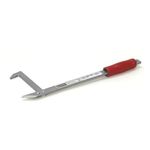So the lights went out in the kitchen today, breaker kicked off. The house is 12 years old, there are two other rooms on the circuit. No changes to the wiring recently, no event connected to the breaker popping off.
I removed light bulbs in the kitchen (6 spotlights in cans) and hardwired the switch, breaker still goes. I would suspect the breaker but the other lights and a fan work fine, it seems to be just the one switched part of the circuit.
What’s the easiest way to track this down? I’ve wired a number of houses but not much debugging.
Thanks in advance,
Fine Homebuilding Recommended Products
Metal Connector Nailer
This time-saving tool is the fastest way to install hardware. The tip is designed to locate the hole in the hardware, then all you have to do is pull the trigger.
Guardian Fall Protection Pee Vee
This tool is a gem! You can use it to align plates with your snapped lines, and it’s especially helpful when working alone.
Homebody: A Guide to Creating Spaces You Never Want to Leave
Joanna Gaines may have started as a celebrity designer on HGTV, but she’s proven to be the real deal. This book help you understand how and why good design works so that you can recreate it on your own.
Nitrile Work Gloves
Do yourself a favor and protect your hands while you work. These lightweight, breathable work gloves will keep your hands safe while cutting and fitting.
Peel & Stick Underlayment
Often required by code, this durable, slip resistant, self-sealing, and self-adhered roofing underlayment is easy to install and ensures maximum protection along roof eaves, rakes, and valleys.




















Replies
hardwired switch? Does that mean bypassed it?
Any chance this circuit runs through a GFCI?
Welcome to the
Taunton University of Knowledge FHB Campus at Breaktime.
where ...
Excellence is its own reward!
The easiest thing to check first is to shut the power off at the breaker then remove the covers from all the boxes in the circuit and look for evidence of shorting. This would include outlets, switches, light fixtures, and junction boxes. If it is not there, it could conceivably be in the wiring somewhere. It is possible (and I have seen it) where a nail gets driven into wiring and then over time as the wood moves the nail moves just enough to short out. The only way to find that is to disconnect portions of the circuit in a logical way and isolate the portion that has the trouble.
Breakers do go bad occasionally, but it is more likely you have a problem in one of the boxes. To test the breaker you'd hook the hot from that circuit to another breaker and see if it trips the other breaker, too.
Do you have an ohm meter (better) or continuity tester?
Do you know how to use it?
If so, employ a basic rule of troubleshooting--the rule of halves.
Start at the panel or the first outlet in the circuit, free the conductors (break any splices or remove from terminals) and test for a short between the hot and neutral and hot and ground. I expect that you'll find a short. If not--replace the breaker.
Let's assume it is indeed a short circuit. You've already isolated the section of the circuit with the short. So, then guesstimate the half-way point in that section. Open up the outlet, switch, or fixture box, at the mid-point and break the splices for all the conductors, and check resistance or continuity between hot-neutral and hot-ground in each direction. There will probably be only one short. By splitting the distance each time, eventually you'll find it. Often much more efficient that opening up all of the devices and fixtures before you start testing.
Keep in mind that in pulling the receptacle or switch out of the box, you may be removing the short. But there'll often be evidence of it--some soot, arc tracking, or metal splatter on a wire or a terminal screw.
Keep in mind that this testing has to be done with power off. And that in some situations, more than one circuit runs through a box. Use a non-contact voltage tester as a screening tool, and a contact voltage tester (NOT a digital multimter, which can be fooled by phantom voltage, energy that bleeds over from an adjacent live cable, due to capacitive coupling) every time you open a box to make sure the wires are not energized.
Good luck. If you're uncertain about how to work around wiring in a house that's got power to it, call a pro. It's easy to get into trouble--to get so focussed on troubleshooting that you forget about an energized wire, and get shocked or electrocuted.
Cliff
Edited 10/16/2005 6:45 pm ET by CAP
Edited 10/17/2005 11:27 am ET by CAP